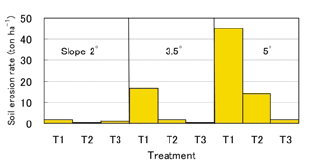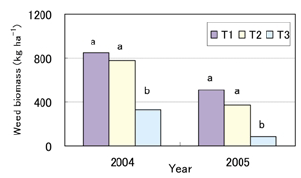Soil and water management techniques through no-tillage farming after leguminous cover cropping
Description
In low-input agriculture in tropical and subtropical regions, soil erosion is a significant cause of loss of soil fertility. In rainfed agriculture, water runoff is another serious problem: it accelerates damage to crops due to low water percolation into the soil in drought-prone areas. No-tillage farming has a long history as a soil erosion control measure; however, no-tillage farming is rare in low-input agriculture due to the need to apply herbicides. A combination of cover cropping together with no-tillage is expected to overcome the weeding problem without the need for herbicide application. At the same time, a leguminous cover crop can be used as a green manure to improve soil fertility. We conducted experiments in no-tillage farming after leguminous cover cropping to elucidate its comprehensive effects on soil erosion, water runoff, weed growth, and crop productivity. Mucuna bean (Mucuna pruriens) and sorghum were used in 2004 as test crops, and maize and hairy vetch (Vicia villosa) in 2005.
Tilling after mucuna bean cropping decreased soil erosion by about 35% compared with tilling after natural fallow (conventional practice), while no tilling after mucuna bean cropping decreased the soil erosion rate by 4% to 5% of that seen with conventional farming practices. Thus, no tilling after mucuna cover cropping is the most effective way to control soil erosion (Fig. 1). The combination of a cover crop with no tillage was also able to decrease water runoff. The increased percolating water, corresponding to reduced water runoff, appears to be effective in reducing water stress experienced by crops in drought-prone areas.
No tilling after mucuna bean or hairy vetch cropping significantly reduced weed biomass due to the presence of plant residue mulch (Fig. 2). Cover cropping thus allows subsequent sorghum or maize notillage farming without herbicide application.
With or without tillage, the cereal crop yields after cover cropping and fertilizer application at half the normal rate or even at zero rate were equal to or greater than those obtained by conventional farming with the full rate of application of fertilizer. These results indicate that leguminous cover copping can be very effective as green manure to increase crop productivity.
Thus, our overall conclusion is that notillage farming after cover cropping is an effective system for limiting soil erosion and water runoff, reducing weed growth, and ultimately increasing crop productivity.
Figure, table
-
Fig. 1. Effects of different treatments and field slopes on soil erosion during the cropping period.
The treatments are a combination of tillage, precropping (fallow or mucuna bean cropping), and fertilizer level. T1: Natural fallow + Tillage + Full fertilizer (100 kgN ha-1), T2: Cover crop + Tillage + Half fertilizer, T3: Cover crop + No tillage + Half fertilizer. -
Fig. 2. Effects of different treatments on weed biomass.
The treatments are the same as those in Fig. 1. Test crop combinations are sorghum after mucuna bean in 2004 and maize after hairy vetch in 2005. Different letters indicate a statistically significant difference (p < 0.05).
- Affiliation
-
Japan International Research Center for Agricultural Sciences Tropical Agriculture Research Front
- Classification
-
Technical A
- Term of research
-
FY2005 (FY2003~2005)
- Responsible researcher
-
NAGUMO Fujio ( Tropical Agriculture Research Front )
HOSIKAWA Akira ( Tropical Agriculture Research Front )
Issaka Roland ( Soil Research Institute, CSIR, Ghana )
ZOUGMORE Robert ( Environmental Institute for Agricultural Research, Burkina Faso )
- ほか
- Publication, etc.
-
Zougmore,R., Nagumo,F. and Hoshikawa,A. (2006): Nutrient uptakes and maize productivity as affected by tillage system and cover crops in a subtropical climate at Ishigaki, Okinawa, Japan. Soil Science and Plant Nutrition. 52: 509-518
Nagumo,F., Issaka,R.N. and Hoshikawa,A. (2006): Effects of tillage practices combined with mucuna fallow on soil erosion and water dynamics on Ishigaki Island, Japan. Soil Science and Plant Nutrition. 52: 676-685
- Japanese PDF
-
2006_seikajouhou_A4_ja_Part21.pdf668.81 KB


